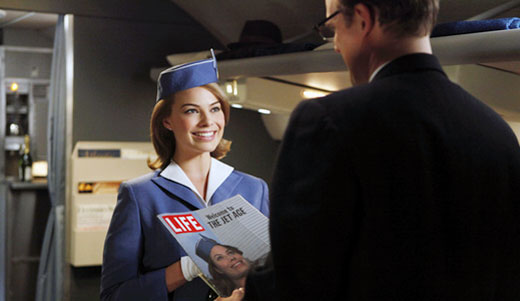
It’s obvious that Pan Am, ABC TV’s ambitious new series, is a major network’s bid to seize the audience that has made Mad Men a cable television sensation.
Is there really that large of an audience that it interested in the early 1960s? There will always be some of us that are (I’m hopelessly in that camp). The mid-century modern look and feel has enduring appeal. Fashions and attitudes were moving in new directions across the world, as the jet age became the space age. And the times they were a-changin’. Anxiety and fun were a strange but compelling pair that shaped the era. Given the right amount of talent all of this could make an excellent television series. Or, rather, another one.
The main problem with Pan Am is that it’s glossy and superficial. Yes, the cultural and media messages of early 60s America were amusing for their gee-whiz over optimism. And I can see how one could use all of that in an ironic way. Mad Men routinely wrings a lot of humor and commentary out of this premise. The producers of Pan Am seem trapped in the picture postcard/glossy magazine ad world they are exploring. Their attempts at commentary are too weak or shallow to rescue the series from being frozen in the many layers of gloss.
The show is far too pretty. Yes, vintage automobiles and jetliners are way cool, and I’m a sucker for the clothing styles of that era. But all this overwhelms any attempt at durable storytelling in Pan Am. Even the way scenes are photographed is too self-conscious. It’s the aesthetics of commercials, not drama.
There’s a lot of business at the beginning of the first episode that pokes fun at the exacting standards of appearance the stewardesses are held to: being weighed in, having their behinds slapped to check how firm their girdles are. But the show is pretty much devoted to the same purpose: everyone and everything is really damn gorgeous! It creates a huge hurdle that the meager amount of substance fails to overcome.
The four principal actors are the show’s greatest strength. All have enough talent to nearly overcome the flat writing. Christina Ricci is the only “name”, but all four leading women are treated to roughly equal attention. So far there hasn’t been too much dimension to how these smart, attractive young women are handling the challenges of being women in this period. The issues all seem rather mechanically approached and resolved. Both of the male leads seem far too contemporary in manner and appearance. In the early 60s men of all ages tended to conform to a standard approach to their roles in society. There were non-conformists, but you wouldn’t find them in the cockpit of an airliner. Mike Vogel is way off the mark as the young captain (as is his hair). He’s a bit too unsure and squishy to seem the sort to hold such a position. Likewise Michael Mosley as first officer. Mosley fits his role better and is the stronger actor (or rather the character is given better writing), but it stretches credibility that men with so many issues would be favored with top jobs at the top airline. Again, Mad Men routinely explores how restrictive and anxious men were in their programmed roles in this era.
The Cold War subplot would be a real asset if it were better realized. There’s again a shallow approach that prevents the whole affair from working. A recent episode crammed JFK’s famous Berlin speech in with leftover WWII resentments (I would have thought Kennedy would be enough). Kelli Garner’s character has a dual identity- stewardess and CIA secret agent. So far it’s been pretty unsatisfying stuff, neither witty nor gritty, just more soap opera level chatter. Again, it’s a missed opportunity for both commentary and some reality-based intrigue.
One needn’t just compare it to Mad Men to see the shortcomings of Pan Am. Comparing it to shows actually produced in the early 60s demonstrates the problem: they were often far more entertaining and more rewarding. It’s early still, and I suppose Pan Am could improve. Perhaps some of the subplots will develop into something worth staying tuned for. I hope so, as I remain devoted to the idea of the show, but I want more than it’s offered six episodes in. Sexy airplanes, beautiful cars, attractive people are all welcome ingredients. But solid storytelling that makes the most of its setting would be nice.
Pan American World Airways, known as Pan Am, was the largest international airline in the U.S. from 1927 until its financial collapse in 1991. — Editors
Photo: ABC Still from Pan Am pilot episode.










